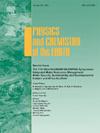纳米金属氧化物吸附去除水/废水中砷的研究进展
IF 3
3区 地球科学
Q2 GEOSCIENCES, MULTIDISCIPLINARY
引用次数: 0
摘要
砷金属污染排放到生态住区是造成当代环境问题的一个重要因素。优先考虑水安全的要求是最近才出现的一个社会问题。纳米金属氧化物如铁、铝、钛、锌等,由于其有效的表面活性位点、丰富的可用性、多孔结构、宽表面积、成本效益、环境友好性和化学稳定性,作为有效去除废水中砷的吸附剂,受到了广泛的关注和研究。本文综述了利用纳米金属氧化物及其衍生物去除废水中砷的最新进展,并从批判的角度进行了分析。对比研究表明,介孔铝镁氧化物是目前合成并用于除砷的亚砷酸盐As(III)和砷酸盐As(V)的最佳吸附剂,在pH 7和pH 3下的吸附量分别为813 mg/g和912 mg/g。本文还介绍了吸附机理、吸附行为和再生情况。重点介绍了未来前景和技术挑战,强调了吸附效果的提高。评估包括实时应用的商业可行性,以及它们在大规模工业一级的潜在利用,以及这些应用的预测前景。本文章由计算机程序翻译,如有差异,请以英文原文为准。
Adsorptive removal of arsenic from water/wastewater using nano-sized metal oxides: A review
The discharge of arsenic metal contamination onto ecological settlements is a significant factor contributing to contemporary environmental concerns. The requirement to prioritize water security has emerged as a relatively recent societal concern. Nano sized oxides of metals like Fe, Al, Ti, Zn, etc. have garnered significant attention and research as promising adsorbents for efficient arsenic removal from wastewater because to their effective surface active sites, abundant availability, porous architectures, wide surface area, cost-effectiveness, environmental friendliness, and chemical stability. This article examines the recent advancements made in the field of eliminating arsenic from wastewater by the utilization of Nano sized metal oxides and their derivatives, with a critical perspective. The comparative study shows that mesoporous aluminium magnesium oxide was found to be the best adsorbent for arsenite As(III) and arsenate As(V) with adsorption capacity of 813 mg/g at pH 7 and 912 mg/g at pH 3, respectively, that has been synthesized and used for arsenic removal to date. This article also provides descriptions of adsorption mechanism, behaviour and regeneration. The enhancement of adsorption efficacy is emphasized by focusing on future prospects and technological challenges. The assessment encompassed the commercial feasibility of real-time applications, as well as their potential utilization on a large-scale industrial level, in addition to the projected outlook for these applications.
求助全文
通过发布文献求助,成功后即可免费获取论文全文。
去求助
来源期刊

Physics and Chemistry of the Earth
地学-地球科学综合
CiteScore
5.40
自引率
2.70%
发文量
176
审稿时长
31.6 weeks
期刊介绍:
Physics and Chemistry of the Earth is an international interdisciplinary journal for the rapid publication of collections of refereed communications in separate thematic issues, either stemming from scientific meetings, or, especially compiled for the occasion. There is no restriction on the length of articles published in the journal. Physics and Chemistry of the Earth incorporates the separate Parts A, B and C which existed until the end of 2001.
Please note: the Editors are unable to consider submissions that are not invited or linked to a thematic issue. Please do not submit unsolicited papers.
The journal covers the following subject areas:
-Solid Earth and Geodesy:
(geology, geochemistry, tectonophysics, seismology, volcanology, palaeomagnetism and rock magnetism, electromagnetism and potential fields, marine and environmental geosciences as well as geodesy).
-Hydrology, Oceans and Atmosphere:
(hydrology and water resources research, engineering and management, oceanography and oceanic chemistry, shelf, sea, lake and river sciences, meteorology and atmospheric sciences incl. chemistry as well as climatology and glaciology).
-Solar-Terrestrial and Planetary Science:
(solar, heliospheric and solar-planetary sciences, geology, geophysics and atmospheric sciences of planets, satellites and small bodies as well as cosmochemistry and exobiology).
 求助内容:
求助内容: 应助结果提醒方式:
应助结果提醒方式:


